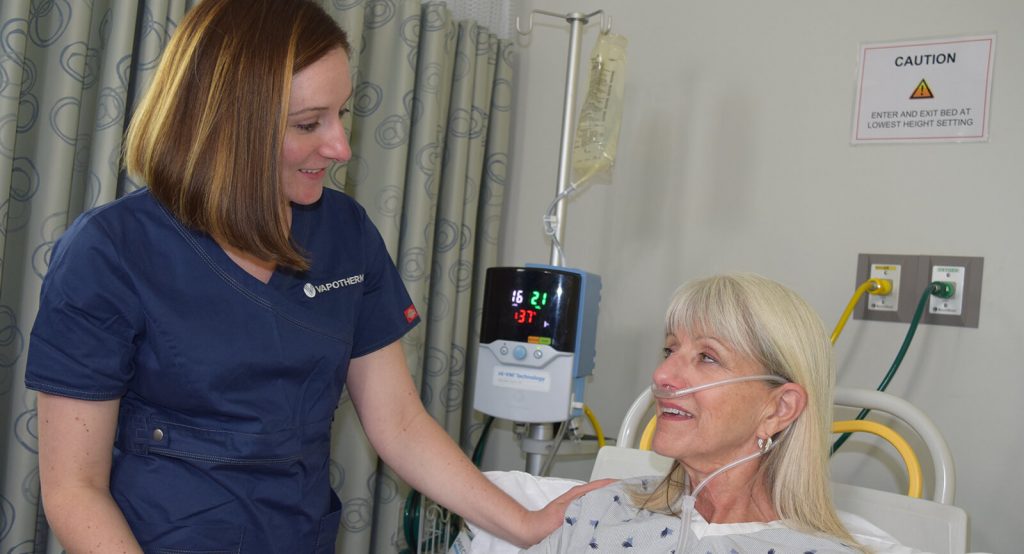COPD Exacerbations During Respiratory Season—How to Help Your Workflow

It’s that time of the year again—Respiratory Season is here, crowding many Emergency Departments, exacerbating underlying respiratory conditions like COPD1, and stressing clinicians as they handle the increased patient volume. Time is of the essence and for some, shortening a workflow by just a little could make a difference in your day. So, how do you do it?
Try Mask-Free NIV®. If you’re thinking your hospital doesn’t have that or you’re not familiar with the term, you may also have heard it called high velocity therapy, high velocity nasal insufflation (HVNI) or sometimes it’s known by the name of the device manufacturer making the technology—Vapotherm®.
Vapotherm high velocity therapy is the only non-pressure based mask-free alternative to non-invasive positive pressure ventilation (NiPPV) for the treatment of undifferentiated respiratory distress.2 In other words:
If a patient comes into your Emergency Department huffing and puffing and needing respiratory support, and you’re not sure why they’re in respiratory distress—all you know is you need to stabilize them and they’re spontaneously breathing—instead of reaching for Bilevel/NiPPV, you can reach for high velocity therapy because there is no increased risk of intubation using high velocity therapy in place of NiPPV. It is simply a mask-free alternative with clinical outcomes that are comparable to those of NiPPV.
Why would this help your workflow with COPD patients?
Easy Interface Fitting

Sometimes you have to go through a few NiPPV masks to find one that’s the right fit for your patient. Sometimes your patient has a bushy beard which compromises the seal that makes NiPPV effective. Sometimes your patient has anxiety and fights the mask. These are a few of the reasons why having a mask-free interface option could help your workflow.
Rather than using a mask, high velocity therapy has a nasal cannula to optimize patient comfort. It makes for easy interface fitting. Additionally, it is an open system that flushes CO2 out of the upper airway, which is why the interface should never occlude more than 50% of the patient’s nares. This means you don’t need to spend any time ensuring there is any kind of seal.
Minimal Patient Coaching
Because the interface is a loosely fitting cannula, patients do not require coaching or training for compliance. This may be especially favorable in cases of patients who have mask-anxiety as anxious patients on NiPPV require coaching, sometimes even sedation, to keep them on the therapy. Sedated patients of course require more monitoring work to ensure their safety.
And then there are about one third of patients who fail NiPPV treatment due to mask-intolerance3 and might progress to more invasive treatment. It’s always desirable to avoid intubations if possible, but it may be especially desirable during Respiratory Season when patient volumes are higher.
Easy Patient Communication

Finally, because of the mask-free interface, patients on high velocity therapy can comfortably eat, speak, drink, and take oral medication. Their mouth isn’t covered, so is no need to pause the therapy to quickly give them a requested drink of water or to better hear them when they speak.
In reality, these reasons could help save some time not just with COPD exacerbations, but with spontaneously breathing all-comers in respiratory distress.
If you are not familiar with high velocity therapy at all, you can learn more in our article “What is Mask-Free NIV?” If your hospital already has this technology, but hasn’t used it to reduce hypercapnia and provide ventilatory support, feel free to download this sample protocol for the Emergency Department. It is based on the protocol used in the randomized, controlled trial by Doshi and colleagues that concluded that Vapotherm high velocity therapy is a mask-free alternative to NIPPV for the treatment of undifferentiated respiratory distress in adults.2
References